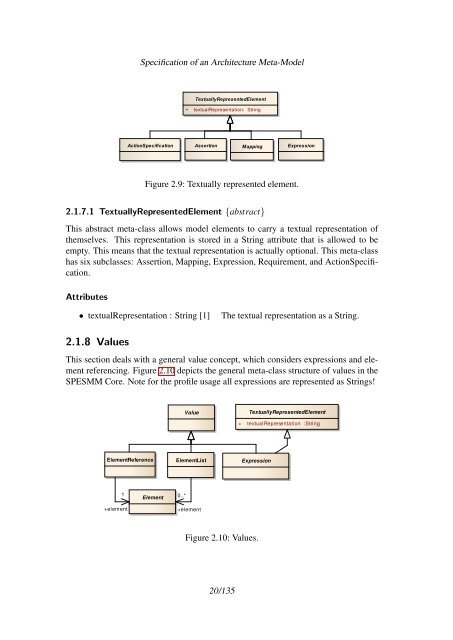Specification of an Architecture Meta-Model - SPES 2020
Specification of an Architecture Meta-Model - SPES 2020
Specification of an Architecture Meta-Model - SPES 2020
Create successful ePaper yourself
Turn your PDF publications into a flip-book with our unique Google optimized e-Paper software.
<strong>Specification</strong> <strong>of</strong> <strong>an</strong> <strong>Architecture</strong> <strong>Meta</strong>-<strong>Model</strong><br />
TextuallyRepresentedElement<br />
+ textualRepresentation: String<br />
Action<strong>Specification</strong> Assertion Mapping<br />
Figure 2.9: Textually represented element.<br />
2.1.7.1 TextuallyRepresentedElement {abstract}<br />
Expression<br />
This abstract meta-class allows model elements to carry a textual representation <strong>of</strong><br />
themselves. This representation is stored in a String attribute that is allowed to be<br />
empty. This me<strong>an</strong>s that the textual representation is actually optional. This meta-class<br />
has six subclasses: Assertion, Mapping, Expression, Requirement, <strong>an</strong>d Action<strong>Specification</strong>.<br />
Attributes<br />
• textualRepresentation : String [1] The textual representation as a String.<br />
2.1.8 Values<br />
This section deals with a general value concept, which considers expressions <strong>an</strong>d element<br />
referencing. Figure 2.10 depicts the general meta-class structure <strong>of</strong> values in the<br />
<strong>SPES</strong>MM Core. Note for the pr<strong>of</strong>ile usage all expressions are represented as Strings!<br />
Value<br />
ElementReference ElementList<br />
1<br />
+element<br />
Element<br />
0..*<br />
+element<br />
TextuallyRepresentedElement<br />
+ textualRepresentation :String<br />
Expression<br />
Figure 2.10: Values.<br />
20/135
















